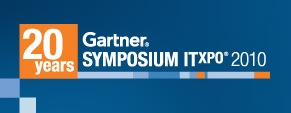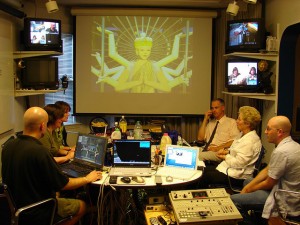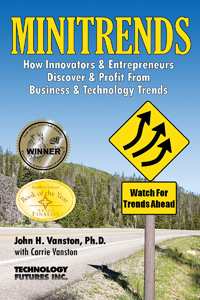9 Futurists Give 2020 Digital World Predictions to Mashable
July 11, 2012

9 Futurists give Mashable's Amy-Mae Elliott predictions for the digital future. Image courtesy of S58y. Used under Creative Commons license, http://creativecommons.org/licenses/by/2.0/deed.en.
We’re always interested in predictions for the future and were excited to be asked by Mashable’s Amy-Mae Elliott for one of our own in her article “9 Bold Predictions for the Digital World of 2020.” Dr. John Vanston chimed in on how voice quality by 2020 will be so excellent that “Younger generations will hear something that theretofore only older generations remember: the sound of a pin dropping.”
A couple of the futurists’ comments in the Mashable article refer to the massive amounts of information that is increasingly available to everyone. According to Dave Evans, Cisco Chief Futurist, “We are amassing unprecedented amounts of data – a zettabyte alone this year. This data is social and public (Facebook, Twitter, YouTube, blogs, etc.). Billions of devices (25-50 billion by 2020) will contribute exponentially to this avalanche of data … By 2015, Cisco Visual Networking Index predicts 1 million video minutes will traverse the Internet every second.”
According to Brian David Johnson, Futurist, Intel, “the size of the meaningful computational power keeps getting smaller and smaller. So, as we approach 2020 the size of the intelligent gets closer to zero in size, nearly invisible.”
Those that can use these massive amounts of information most imaginatively will have a very real advantage in the coming years. A good way to winnow through the information is finding minitrends in your areas of interest within the larger emerging trends. We talk extensively about this on this site and in our MINITRENDS book. Also stay tuned for our formal announcement of MINITRENDS 2012: A Conference on Translating Emerging Trends Into Business Opportunities scheduled October 17-18 at the Omni Downtown in Austin.
We are also intrigued by futurist Mike Walsh comments about virtual avatars: “By 2020 retail virtual avatars – on screens and in holographic projection – will start to become popular.” Perhaps, these virtual avatars will be waiting on us in the not too distant future!
We talk about Virtual Worlds being a minitrends opportunity in MINITRENDS. For the free excerpt from the book, see “Expanding Involvement in Virtual Worlds.”
Cheers,
Carrie
Accenture IT Report Encourages Businesses to Lose Control
February 22, 2011
 Is your business ready to lose control? That appears to be the direction of enterprise computing, according to a new set of predictions just released by management consulting powerhouse, Accenture.
Is your business ready to lose control? That appears to be the direction of enterprise computing, according to a new set of predictions just released by management consulting powerhouse, Accenture.
In the free report, Accenture Technology Vision 2011, Accenture’s information technology (IT) team, led by Kevin Campbell, chief executive of the company’s technology group, reviewed such sources as the subjects of keynote speeches at technology conferences, the types of projects receiving venture capital funding, and the predictions of well known IT experts. These sources are similar to those John and Carrie Vanston recommend consulting when analyzing the viability of trends in their book, MINITRENDS. The Accenture report arrives at a short list of eight trends that are transforming IT.
Accenture sees “a world of IT that barely resembles what enterprise computing looks like today,” according to Gavin Michael, Accenture’s managing director of research and development, as quoted by TMCnet reporter, Rajani Baburajan. “IT is no longer in a support role. Instead, it is front and center driving business performance and enriching people’s lives like never before,” Michael said.
Accenture sees three major rivers running through its predictions:
- Greater Distribution of Data: “Data is dispersed across many more locations, and under the control of far more owners.”
- The Separation of Software and Hardware: “Technology today enables decoupling of entities and layers once deemed inseparable.”
- The Meteoric Rise of Analytics: “Analytics will become the super-tool with which to drive more agile and effective decision-making.”
You have to be something of a mindreader to parse the jargon of the report and glean the pearls of wisdom it contains, but they are there. Accenture sees decentralization at the core of technology trends, such as cloud computing, which we have frequently covered on this blog.
The report’s insight that IT security needs to move from a “fortress mentality” to a layered and distributed series of security checks is prescient, as is the awareness that greater automation in security and the ability of software to handle “noise” will improve results. Imagine how the technology behind IBM’s Watson (the new Jeopardy champion) will enable computers to understand natural language and anticipate security breaches instead of waiting for an attack.
The Accenture report, like most similar surveys, sees the rise of the social platform in enterprise computing. The website will no longer be the primary connection point between an organization and its constituents. Companies will have to set up shop where the consumer is — on sites such as Facebook and Netflix — rather than waiting for the consumer to come to them.
The report concludes with this powerful insight: The primary role of IT in the past has been to reduce an organization’s costs; in the future, it will be to enhance the user experience. The authors of the report foresee technology that goes beyond Apple Computer’s famously intuitive user experience to something that instantly and seamlessly shapes itself to the unique characteristics of the user.
Accenture’s vision is at once thrilling and unsettling. Organizations will have to move out of their bunkers, distributing their computing resources and allowing users to take control. Like a fast-paced, high-tech amusement ride, it’s going to be scary but enjoyable for those entities able to loosen up and cede control of their IT resources to the audiences they are charged with serving.
STEVE O’KEEFE
News Editor, Minitrends Blog
Source: “Accenture Technology Vision 2011” (PDF), Feb. 7, 2011
Source: “Accenture Maps Eight Trends That Will Drive Future of IT,” infoTech Spotlight, Feb. 9, 2011
Image by Mulad (Michael Hicks), used under its Creative Commons license.
IDC Sees Perfect Storm in Portable Computing
December 8, 2010

On December 2, International Data Corporation (IDC), the giant IT research firm out of Framingham, Massachusetts, released its annual predictions for IT in the coming year. The firm is forecasting a perfect storm for IT: a combination of cloud computing, mobile computing, and social networking that threatens to consign desktop PCs to the storage closet.
The author of the survey is IDC’s chief analyst, Frank Gens, who leads IDC’s 1,000 analysts in 110 countries in tracking IT trends. Summarizing this year’s report, Gens sees a nearly complete transformation in the dominant computing platform:
What really distinguishes the year ahead is that these disruptive technologies are finally being integrated with each other — cloud with mobile, mobile with social networking, social networking with ‘big data’ and real-time analytics. As a result, these once-emerging technologies can no longer be invested in, or managed, as sandbox efforts around the edges of the market. Instead, they are rapidly becoming the market itself and must be addressed accordingly.
As the IDC report ripples through the Internet, different players are examining what it means for the future of computing. At ComputerWorld, Sharon Gaudin comments on the surge in social networking, suggesting that business startups will stop building expensive and complicated websites and opt for free Facebook pages instead.
Anuradha Shukla at TechWorld is enthusiastic about IDC’s upbeat predictions for IT expenditures. The report forecasts a 5.7% increase in outlays over 2010, to $1.6 trillion worldwide. IDC sees half of that spending coming from emerging market countries shrugging off the recession.
At PC World, Patrick Thibodeau focuses on IDC’s prediction that shipments of apps-enabled mobile devices — smartphones and tablets — will surpass shipments of PCs in the next 18 months. Thibodeau points out, however, that shipments of PCs are not declining; rather, they are growing, but not nearly as quickly as mobile devices.
Another prediction that is sure to catch the eye of venture capital firms: Gens says that nearly a third of the major players in social networking will be bought up in the coming year by the likes of Oracle, Microsoft, HP, and IBM, who need to get in the game.
While many others futurists we have covered on the Minitrends blog have made similar predictions about the growth in cloud computing, mobile computing, and social networking, none of them have joined them together with such a powerful vision of a whole new way of working that Frank Gens brings to IDC’s report.
What do you think is coming in 2011? Do you think it will be just more of the same, or the beginning of a totally new platform, as the IDC report speculates? We welcome your comments.
STEVE O’KEEFE
News Editor, Minitrends Blog
Source: “IDC Predicts Cloud Services, Mobile Computing, and Social Networking to Mature and Coalesce in 2011, Creating a New Mainstream for the IT Industry,” IDC Press Release, 12/02/10
Source: “Business will get more social in 2011, IDC says,” ComputerWorld, 12/06/10
Source: “Cloud services, mobile computing and social networking to mature in IT industry,” TechWorld, 12/07/10
Source: “In historic shift, smartphones, tablets to overtake PCs,” PC World, 12/07/10
Photo by davedehetre (David DeHetre), used under its Creative Commons license.
Lundquist: Service Is Top Tech Trend for 2011
December 1, 2010
 December marks the peak season for looking back on trends from the previous year and forward to trends in the coming year. We’d like to start the month at the Minitrends Blog by sharing the forecasts of famous prognosticators in technology trends to see where they are pointing.
December marks the peak season for looking back on trends from the previous year and forward to trends in the coming year. We’d like to start the month at the Minitrends Blog by sharing the forecasts of famous prognosticators in technology trends to see where they are pointing.
First up is Eric Lundquist. Lundquist is a fixture at Ziff Davis Enterprise, where he has ridden the waves of publishing trends as he reports on technology trends. The Harvard-educated scientist began his career as a journalist (you remember what those are, don’t you?), honing his craft as a daily newspaperman. A newspaper is collection of alphabet in ink on paper that was written yesterday, about today, and is worthless tomorrow.
Lundquist joined Ziff Davis back when eWeek was named PC Week, and quickly rose to editor-in chief of that publication. Following his own advice that video is growing as a method of information delivery, Lundquist moved into video production as creator of CIO Insight, a program on The Pulse Network, which combines streaming video with social networking.
In 2009, Lundquist revealed a love-hate relationship in his technology forecast for 2010. Along with the usual suspects (cloud computing, the migration to mobile, etc.), Lundquist expected CIOs to suffer from whiplash as the economy cut their budgets at a time when IT should be growing its budget. He has similar mixed feelings over social networks, seeing them as a growing trend and a growing source of embarrassment for thoughtless executives.
In his new forecast for 2011, the operative word is “service.” Lundquist predicts that most CIOs will have to evaluate and purchase software as a service in 2011. He also sees the rise of “apps” allowing employees to test and choose services rather than the CIO. He sees social networking, tablets, and mobile platforms all working hard to service business and B2B users who need to communicate on closed networks. He concludes his forecast by lauding the Apple Store for its $99/year training service that has created real-world (not virtual) communities of users.
Mixed-in with Lundquist’s predictions for 2011 are some of the usual suspects: the continuing migration to mobile, cloud computing, virtualization, and tablets. Included is his steadfast belief that “video will take a front seat for businesses to provide new product details, showcase executives, and create how-to explanations for their products and services.” Could this be the last time we see Eric Lundquist’s predictions in print? Enjoy the alphabet while you can.
STEVE O’KEEFE
News Editor, Minitrends Blog
Source: “Lundquist’s Top Tech Trends for 2011,” CIO Insight, 11/19/10
Source: “Ten Top Tech Stories of 2009,” CIO Insight, 12/15/09
Source: “CIO Insight,” The Pulse Network
Photo courtesy of fdecomite, used under its Creative Commons license.
What’s the Hottest New Tech Trend? Ranking Hot New Tech Trends
October 28, 2010
 The National Aeronautics and Space Administration, better known as NASA, has a new mission. No, I don’t mean we’re going to Mars, although that certainly is on NASA’s radar. Rather, NASA seeks to become the information technology (IT) leader for the U.S. government.
The National Aeronautics and Space Administration, better known as NASA, has a new mission. No, I don’t mean we’re going to Mars, although that certainly is on NASA’s radar. Rather, NASA seeks to become the information technology (IT) leader for the U.S. government.
This new mission was revealed by NASA’s chief administrator Charles F. Bolden last month, when he opened NASA’s first Information Technology Summit. Among the luminaries making presentations at the summit were:
- James Stikeleather, Chief Innovation Officer, Dell Services
- Mark Bregman, Chief Technology Officer, Symantec
- David W. Cearley, Vice President and Gartner Fellow in Research, Gartner, Inc.
- Vint Cerf, Vice President & Chief Internet Evangelist, Google
- Vivek Kundra, Chief Information Officer, United States of America
NASA has kindly made the videos of these hour-long presentations freely available online. Anyone interested in IT trends is encouraged to review them. Of keen interest to Minitrends Adventurers is James Stikeleather’s take on the future of IT. Internet immortal, Alexander Wolfe, the editor-in-chief of InformationWeek.com famous for reporting on the Pentium “floating point” bug, recently spoke with Stikeleather and came away with this interesting perspective:
[…C]ompanies are attempting to codify the processes through which innovation can be nurtured. More important than ideas, which quite frankly are cheap, is the ability to pick which concepts are worthy of the heavy investment of time, money, and corporate mindshare required to take them to productization.
Leading the pack here is Dell. At the InformationWeek 500 Conference, I spoke with Chief Innovation Officer James Stikeleather, who is working to establish and spread a methodology for innovation throughout the computer powerhouse.
This desire to handicap ideas based on the ability to bring them profitably to market is at the core of MINITRENDS, the new book by John and Carrie Vanston. The authors lay out a systematic process for evaluating ideas in order to uncover those with a development time frame of two to five years.
Wolfe made his remarks in a column a few days ago on The Top 5 Tech Trends in 2011. Along with the need to grade ideas based on their short-term feasibility, Wolfe sees these as the big IT issues in the coming year:
- Data Visualization, to make sense of the overwhelming amount of information businesses are collecting and have stored up.
- Rebellion Against Maintenance Fees, by businesses that are tired of paying ransom to software companies for maintenance contracts they barely use.
- Enterprise 2.0, the integration of social networking into business enterprises, which Wolfe sees as a mixed bag but a major issue in the coming year.
- The Internet Is Making Us Stupid, by reducing attention spans to the point where reading Wolfe’s column feels like reading War and Peace.
Wolfe’s top tech list is quite a bit different from the other year-end lists we’ve been covering here on the Minitrends Blog. While most forecasters are focused on cloud computing and mobile technology, Wolfe’s list has a decidedly human element to it. He sees most trends coming not from a lust for the new, but from a need to fix a pressing problem. The Vanstons also cite alleviating pain, rather than pursuing pleasure, as a major driving force behind new technology.
As we continue our year-end look at tech trends, we’re anxious to hear your top picks. Will the hot trends for the new year propel us into a new world or shield us from it? We welcome your comments.
STEVE O’KEEFE
News Editor, Minitrends Blog
Source: NASA Information Technology Summit Videos, NASA, 08/10
Source: “Top 5 Tech Trends For 2011,” InformationWeek.com, 10/23/10
Image by http2007, used under Creative Commons license.
Intelligence Economy Has Arrived, Says Gartner Guru Sondergaard
October 21, 2010
 Peter Sondergaard, head of research for consulting giant, Gartner, Inc., in his opening remarks at the Gartner Symposium in Orlando, Florida, on October 18, forecast that “we are on our way to an IT-driven intelligence society,” according to Michael J. Miller on PC Magazine‘s Forward Thinking blog.
Peter Sondergaard, head of research for consulting giant, Gartner, Inc., in his opening remarks at the Gartner Symposium in Orlando, Florida, on October 18, forecast that “we are on our way to an IT-driven intelligence society,” according to Michael J. Miller on PC Magazine‘s Forward Thinking blog.
Miller is the former Chief Content Officer for Ziff Davis Media and the editor of Forward Thinking. His coverage of Sondergaard’s remarks is extensive and compelling. He quotes Gartner guru Sondergaard as saying:
By 2012, the Internet will be 75 times larger than it was in 2002.
Gartner’s Symposium doubles as an Information Technology (IT) expo. Ten days ago, Gartner released its much-hyped Hype Cycle, boosting visibility in advance of the big event. We criticized the “emerging technology” Hype Cycle here for excluding social networking.
According to Miller, Sondergaard included “social computing” in his list of the top four trends driving IT in his opening remarks. The other three are context-aware computing, pattern-based strategy, and cloud computing, which Gartner’s own HypeCycle says is “past its peak.”
Miller quotes Sondergaard:
Information will be the oil of the 21st century.
In their book, MINITRENDS, John H. Vanston and Carrie Vanston cover the Minitrend of Increasing Use of Electricity in Industrial Processes, where they discuss the concept that the value of goods increases with the amount of information contained in them:
Manufacturing can be defined as the transformation of materials from one form to another more valuable form using energy and information. In general, the greater the information content of the process, the greater the efficiency, the smaller the waste of material and energy, and the smaller the pollution-producing side streams will be. For example, sand can be used as filler for asphalt, as a component of fine china, or as a ingredient in an electronic computer chip. The basic difference between these uses is the amount of information embedded in the silicon (sand) during the production process. Electrical processes can be used to materially increase information content to material.
That mindbending little excerpt comes courtesy of the Edison Electric Institute. It’s one of the interesting trends John and Carrie have uncovered in this book.
If you are looking for a Minitrend Adventure, think about how you can increase the information content in the things around you — before someone else does.
STEVE O’KEEFE
News Editor, Minitrends Blog
Source: “Four Big Trends Changing Computing, Gartner Says,” PCMagazine, Forward Thinking Blog, 10/18/10
Source: Gartner Symposium Live Blog (SymLive), 10/17/10 – 10/21/10.
Image of the Gartner Symposium 2010 logo is used under Fair Use: Reporting.
New Forrester Report on Technology Trends Highlights Customer Communities
October 19, 2010
 Microsoft’s resident business psychologist Bill Ives recently offered a sneak preview of a new Forrester report on “The Top 15 Technology Trends EA Should Watch: 2011 To 2013.”
Microsoft’s resident business psychologist Bill Ives recently offered a sneak preview of a new Forrester report on “The Top 15 Technology Trends EA Should Watch: 2011 To 2013.”
Forrester has some interesting technology terminology. An “EA,” for example, is an “enterprise architect,” a pretty slick new term for an entrepreneur, CEO, or the person who calls the shots — if not for the company, then for some significant division of the company, such as the IT department. IT as in “information technology.”
The Forrester report is focused on information technology rather than, say, manufacturing technology, which has some of its own pretty important trends. The Forrester report is prepared by analysts, and not just surveys, although this year they did ask business executives to rank 40 emerging technologies in terms of their importance in the coming years. The winners are:
- Mobile devices and applications
- Web 2.0 and social media
- Business intelligence
- Virtualized computing (Cloud computing)
- Computer and mobile security issues
- Software-as-a-service (SaaS)
One interesting aspect of the Forrester report is the timeline. Like Minitrends, it focuses on technology trends that are expected to pay off in the not too distant future. One of the trends that particularly peaked Ives’ interest at FASTforward is the way businesses are developing and using customer communities:
Organizations can use these customer communities to support market research and product development and gain insights from their market for real competitive advantage. I have recently talked with a number of vendors who are working to support this trend. It is predicted that this trend will have a high business impact and low IT impact and I would agree.
The Forrester report costs $499. Ives’ shrewd commentary on this and other matters important to Minitrends entrepreneurs is available free of charge at Microsoft’s FASTforward blog.
STEVE O’KEEFE
News Edtior, Minitrends Blog
Source: “Forrester on Top 15 Technology Trends Enterprise Architects Should Watch: 2011 To 2013,” FASTforward Blog, 10/18/10
Source: “The Top 15 Technology Trends EA Should Watch: 2011 To 2013,” Forrester Research, 10/14/10
Image by John E. Lester, used under its Creative Commons license.


